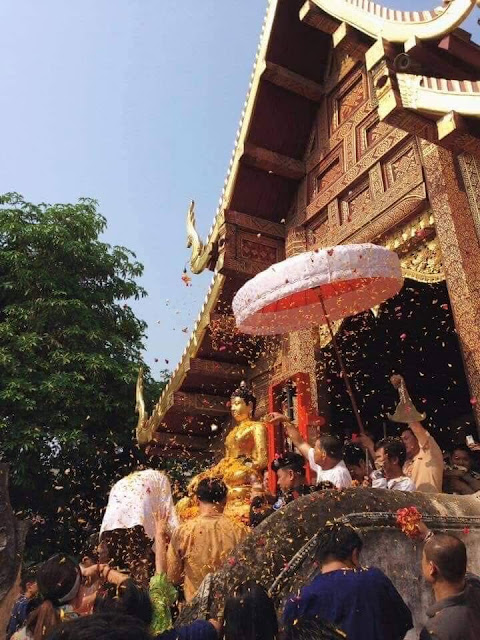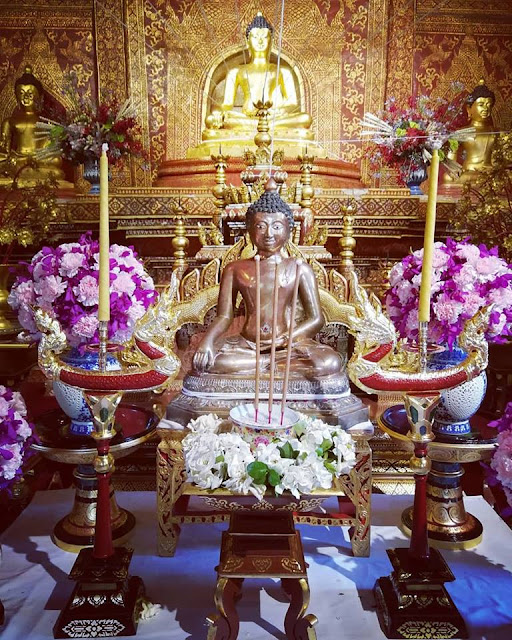Wat Phra Singha Temple
Lek Wara Id
ไหว้สาพระสิงห์...เจินพระสิงห์ ปี๋ใหม่เมือง เจียงใหม่เจ้า
พิธีอาราธนาพระพุทธสิหิงค์ วัดพระสิงฆ์วรมหาวิหารขึ้นรถบุษบก เข้าร่วมขบวนแห่สรงน้ำพระ สงกรานต์เชียงใหม่62
#ความสุขเล็กๆ
Wat Phra Singh, full name: Wat Phra Singh Woramahawihan is a Buddhist temple complex in Chiang Mai, Thailand. Located in the old town, its main portal guarded by stone lions sits at the end of Chiang Mai’s main street, Ratcha Damnoen Road. It is one of the city’s most famous attractions, next to Wat Doi Suthep and Wat Chedi Luang.
Wat Phra Singh was built in the 14th century after it was commissioned by the former King Pha Yu. In the 18th century, the temple was abandoned due to the Burmese occupation of the city and abandoned to decay. In two major renovations Wat Phra Singh was brought back to its former glory: While from 1920 mainly minor defects were improved, the gold leaf decorations got a new coat of paint in 2002.
Of particular importance to the people of Chiang Mai is a unique Buddha statue: Phra Phutta Sihing has made an eventful journey, supposedly coming to Chiang Mai via India and Sri Lanka and becoming one of the city’s most important figures. Also known as The Lion’s Buddha Monastery or The Lion’s Buddha Temple, the temple is an active temple with hundreds of monks and novices living there.
Janine Yasovant :Writer
As I was writing this article, it was a New Year in many countries in Asia. It was time to celebrate the year with both a religious ceremony and the ordinary enjoyment of a family’s days together
Songkran Festival (New Year’s Festival) in Thailand is celebrated on 13-15 April every year. It is, by far, the most popular festival in Thailand for both Thai people and foreigners alike, even though in some quarters it has become a rowdy, fun-seeking, and occasionally disrespectful activity. But for most, it is a time of purification, renewal and celebration.
Many countries near Thailand also celebrate this festival: Laos, Cambodia, Myanmar (Burma) and Thai people in Yunnan of China. Sri Lanka also celebrates a similar festival called Sinhalese, and the Tamil New Year coincides with this festival. In India, the Assamese, Bengali, Oriya, Tamil, Punjabi, and Malayali New Year falls on the same dates. The same date is celebrated widely throughout the Indian subcontinent, albeit based on the astrological event of the sun beginning its northward journey.
Songkran Festival in Thailand
Nowadays, the emphasis is on fun and water-throwing rather than on the festival's spiritual and religious aspects, which sometimes prompts complaints from traditionalists. In recent years there have been calls to moderate the festival to lessen the many alcohol-related road accidents as well as injuries attributed to extreme behavior such as water being thrown in the faces of traveling motorcyclists.
The most obvious celebration of Songkran is the throwing of water. People roam the streets with containers of water or water guns, or post themselves at the side of roads with a garden hose and drench each other and passersby. This, however, was not always the main activity of this festival. Songkran was traditionally a time to visit and pay respects to elders, including family members, friends and neighbors.
Besides the throwing of water, people celebrating Songkran may also go to a Wat (Buddhist temple-monastery) to pray and give food to the monks. They may also cleanse Buddha images in household shrines as well as Buddha images at monasteries by gently pouring water mixed with a Thai fragrance over them. It is believed that doing this will bring good luck and prosperity for the New Year. In many cities, such as Chiang Mai, the Buddha images from all of the city's important monasteries are paraded through the streets so that people can toss water at them, ritually 'bathing' the images, as they pass by on ornately decorated floats.
In northern Thailand, people may carry handfuls of sand to their neighborhood monastery in order to recompense the dirt that they have carried away on their feet during the rest of the year. The sand is then sculpted into stupa-shaped piles and decorated with colorful flags.
One of the traditional values points to the Thai family and the opportunity for family members to express their respect for their elders. Younger members of the family pour scented water on the hands of their parents, and grandparents. They may present them with gifts or tokens of their love. In return, elders wish youngsters good luck and prosperity.
In temples, elder members of the family gather to make merit, offering alms to the monks. They may help clean the temple courtyard, or perform bathing rites for Buddha images
In the past, the fun of splashing water on friends or strangers had to wait until the late afternoon when the religious duties and ceremonies were over. That is not always true today.
The Songkran Festival is an important part of the public relations campaign of the Thai tourism authority to support culture and enjoyment of people in Thailand and all over the world. It is, after all, a festival that welcomes everyone.
จานีน ยโสวันต์
ในขณะที่ดิฉันกำลังเขียนบทความนี้ เป็นวันขึ้นปีใหม่ของหลายประเทศในทวีปเอเชีย เป็นเวลาเฉลิมฉลองปีใหม่พร้อมกับการทำพิธีกรรมทางศาสนาและมีความสุขในวันครอบครัวร่วมกัน เทศกาลสงกรานต์ในประเทศไทยจะถูกจัดขึ้นในวันที่ 13 – 15 ของทุกปี นี่เป็นเทศกาลที่ได้รับความนิยมมากที่สุดสำหรับชาวไทยและต่างประเทศ แม้ว่าในบางพื้นที่จะกลายเป็นกิจกรรมที่เสียงดัง หา
ความสนุกเกินควร และหยาบคายมากเกินไป แต่ส่วนมากแล้วนี่เป็นเวลาแห่งการชำระล้าง การเริ่มใหม่และการเฉลิมฉลอง
หลายๆประเทศที่อยู่ใกล้กับประเทศไทยก็เฉลิมฉลองเทศกาลนี้เช่นกันประเทศลาว กัมพูชา พม่า และชาวไทในยูนนานของประเทศจีน ศรีลังกาก็ฉลองเทศกาลเหมิอนกันเรียกว่า “Sinhalese” และวันปีใหม่ของชาวเผ่าทมิฬก็ตรงกับเทศกาลนี้เช่นกัน ในประเทศอินเดียวันขึ้นปีใหม่ ชาวอัสสัมชาวเบงกอล ชาวโอริสสา ชาวทมิฬ ชาวปัญจาบ ชาวมาลายา เป็นวันเดียวกันในวันนั้นมีการฉลองไปทั่วแคว้นต่างๆ ตามเหตุการณ์ทางโหราศาสตร์ที่พระอาทิตย์เดินทางขึ้นสู่ทิศเหนือ
ตำนานวันสงกรานต์
ในแคว้นโอริสสารัฐทางตะวันออกของประเทศอินเดียนี่เป็นปีใหม่และเป็นที่ทราบกันว่าเป็น มหา วิสุภะ สังกรานติ ซึ่งหมายถึงการเปลี่ยนแปลงอันศักดิ์สิทธ์ที่เกี่ยวข้องกับการเปลี่ยนตำแหน่งของพระอาทิตย์ ตามตำนานเรื่องราวเกี่ยวข้องกับท้าวกบิลพรหมและเจ้าชายธรรมบาลที่เกิดในตระกูลที่ร่ำรวยเจ้าชายธรรมบาลเป็นผู้ที่เฉลียวฉลาดมากตั้งแต่ยังเด็กท้าวกบิลพรหมถามคำถามสามข้อโดยมีเงื่อนไขว่าถ้าคำตอบของเขาถูกต้อง ท้าวกบิลพรหมเต็มใจที่จะเสียสละมอบศีรษะให้ แต่ถ้าเขาตอบผิดเจ้าชายธรรมบาลก็จะต้องทำเช่นเดียวกัน คำถามจะเน้นเรื่องราศีของมนุษย์ในแต่ละช่วงของวันตั้งแต่
ตอนเช้าถึงตอนเย็น ท้าวกบิลพรหมรู้สึกประหลาดใจมากที่เจ้าชายธรรมบาลสามารถตอบคำถามทั้งหมดได้ถูกต้อง เป็นที่ทราบกันมาว่าราศีที่ดีของคนในตอนเช้าคือใบหน้า ในตอนกลางวันคือทรวงอก และในตอนเย็นคือเท้า ดังนั้นท้าวกบิลพรหมจึงต้องตัดศีรษะของตนเองตามข้อเสนอ แต่อย่างไรก็ตามศีรษะของท้าวกบิลพรหมมีอำนาจมาก โลกทั้งใบจะลุกเป็นไฟถ้าศีรษะสำผัสกับพิ้นและความแห้งแล้งอย่างรุนแรงจะเกิดขึ้น น้ำในมหาสมุทรจะแห้งเหือดถ้าศีรษะถูกขว้างไปในอากาศหรือตกลงไปในมหาสมุทร ท้าวกบิลพรหมได้สั่งให้บุตรสาวนางฟ้าทั้ง 7 องค์คอยผลัดกันประคองศีรษะวนรอบเขาพระสุเมรุ และ
ถ้าวันสงกรานต์(13 เมษายน)ตรงกับวันใด ปีนั้นก็เป็นเกียรติแก่นางสงกรานต์ประจำวันนั้น
ในปีนี้วันสงกรานต์ตรงกับเสาร์ ที่ 13 เมษายน 2562 นางสงกรานต์คือทุงษะเทวี สวมชุดสีแดงและกำไลข้อมือ มือขวาถือกงจักร มือซ้ายถือหอยสังข์หลังใบหูทัดดอกทับทิม พาหนะคือครุฑ และก็มีการเดินขบวนประกวดนางสงกรานต์ในวันสงกรานต์เช่นเดียวกัน
การทำนายสำหรับปีใหม่จะมีขึ้นตามวันประจำนางสงกรานต์ ตัวอย่างเช่นถ้าอาหารที่ชอบของนางสงกรานต์คือถั่วและงา ก็จะทำนายได้ว่าปีนั้นก็จะมีความอุดมสมบูรณ์แลสุขภาพดี ถ้าอาหารที่ชอบเป็นเลือด การทำนายนั้นจะบอกว่าเป็นปีที่เลวร้ายมีการทะเลาะเบาะแว้งและความยากลำบาก และถ้า“นางสงกรานต์”ชอบถืออาวุธก็จะทำนายได้ว่าสภาพอากาศจะมีพายุฝนและความไม่สะดวกสบายต่างๆ
แต่เดิมแล้ววันจัดงานเทศกาลนั้นจะจัดขึ้นโดยการคำนวณทางโหราศาสตร์ แต่ตอนนี้ถูกกำหนดไว้แน่นอนแล้ว ถ้าวันเหล่านี้ตรงกับวันหยุดสุดสัปดาห์ วันธรรมดาถัดมาก็จะเป็นวันหยุดชดเชยทันที สงกรานต์อยู่ในช่วงเวลาที่ร้อนที่สุดแห่งปีในประเทศไทยช่วงปลายหน้าแล้ง จนกระทั่งปีพ.ศ. 2431 วันขึ้นปีใหม่ไทยเป็นวันแรกของปีในประเทศไทย ต่อมาเปลี่ยนเป็น 1 เมษายนจนกระทั่งปีพ.ศ. 2483 เมื่อวันที่ 1 มกราคมกลายเป็นวันเริ่มต้นของปี วันปีใหม่แบบดั้งเดิม
จึงกลายเป็นวันหยุดประจำชาติตั้งแต่นั้นมา
ไม่น่าสงสัยเลยว่าสงกรานต์เป็นเทศกาลที่นิยมมากที่สุด นั่นคือการเริ่มต้นแห่งปีใหม่ทางโหราศาสตร์ที่ถูกกำหนดโดยปฎิทินเก่าแก่ของสยาม ตามประเพณีวันที่ 13 คือวันมหาสงกรานต์ วันที่ 14 คือวันเนา และวันที่ 15 คือวันเถลิงศกซึ่งเป็นการเริ่มต้นปีใหม่
เทศกาลสงกรานต์ในประเทศไทย
ทุกวันนี้จะเน้นแต่ความสนุกสนานและการสาดน้ำมากกว่าจิตวิญญาณของเทศกาลและศาสนา ซึ่งบางทีก็ได้รับคำตำหนิจากนักประเพณีนิยม ในปีที่ผ่านๆมามีการประกาศเรื่องการลดอุบัติเหตุจากเครื่องดื่มแองกอฮอล์และการบาดเจ็บจากการสาดน้ำใส่หน้าผู้ขับขี่มอเตอร์ไซด์ การเฉลิมฉลองที่ชัดเจนของสงกรานต์คือการสาดน้ำด้วยขันน้ำและปืนฉีดน้ำหรือไปอยู่ด้านข้างถนนคอยรดน้ำพวกเดียวกันหรือผู้ที่เดินผ่านมา อย่างไรก็ตามนี่ก็ไม่ได้เป็นกิจกรรมหลักของเทศกาลนี้ ตามประเพณี สงกรานต์เป็นเวลาที้จะไปเยี่ยมและเคารพผู้ใหญ่ ครอบครัว เพื่อนสนิทมิตรสหาย เพื่อนบ้านใกล้เรือนเคียง
นอกจากการสาดน้ำแล้ว ผู้คนที่ฉลองงานสงกรานต์อาจไปวัดเพื่ออธิษฐานขอพรและถวายอาหารแด่พระสงฆ์ บางคนอาจสรงน้ำพระพุทธรูปที่บ้านหรือที่วัดด้วยน้ำอบไทย มีความเชื่อว่าการกระทำเช่นนี้จะนำความโชคดีและความสงบสุขมาสู่ปีใหม่ ในหลายๆจังหวัดเช่นเชียงใหม่ มีการพระพุทธรูปสำคัญหลายองค์มาจัดขบวนพาเหรดให้ผู้คนสรงน้ำกัน ในตอนเหนือของประเทศไทยผู้คนจะขนทรายเข้าวัดเพื่อมาที่นำทรายออกจากวัดในช่วงตลอดปี ทรายนั้นจะถูก
นำมาปั้นเป็นสถูปเจดีย์ตกแต่งด้วยธงเล็กๆหลากสีหนึ่งในค่านิยมประเพณีของครอบครัวไทยและโอกาสที่จะแสดงความเคารพ
ผู้ใหญ่ สมาชิกหนุ่มสาวของครอบครัวรดน้ำให้กับพ่อแม่ ปู่ย่าตายาย และมอบของขวัญแสดงความรักให้กับพวกท่าน ส่วนผู้ใหญ่จะอวยพรให้บุตรหลานโชคดีมีความสุขภายในวัด สมาชิกในครอบครัวไปทำบุญตักบาตรพระสงฆ์ อาจช่วยกันกวาดพื้นและลานวัดหรือสรงน้ำพระพุทธรูป ในอดีตต้องรอให้กิจกรรมและพิธีทางศาสนาสิ้นสุดก่อนที่จะสาดน้ำเล่นกันในหมู่เพื่อนฝูงและคนแปลกหน้าได้ แต่ใน
ปัจจุบันไม่เป็นเช่นนั้นอีกต่อไปแล้ว
เทศกาลสงกรานต์เป็นส่วนสำคัญของการประชาสัมพันธ์ของการท่องเที่ยวแห่งประเทศไทยเพื่อสนับสนุนวัฒนธรรมและความสุขสำหรับผู้คนในประเทศไทยและจากทั่วโลก ท้ายที่สุดแล้วเทศกาลนี้ต้อนรับทุกคน








































No comments:
Post a Comment